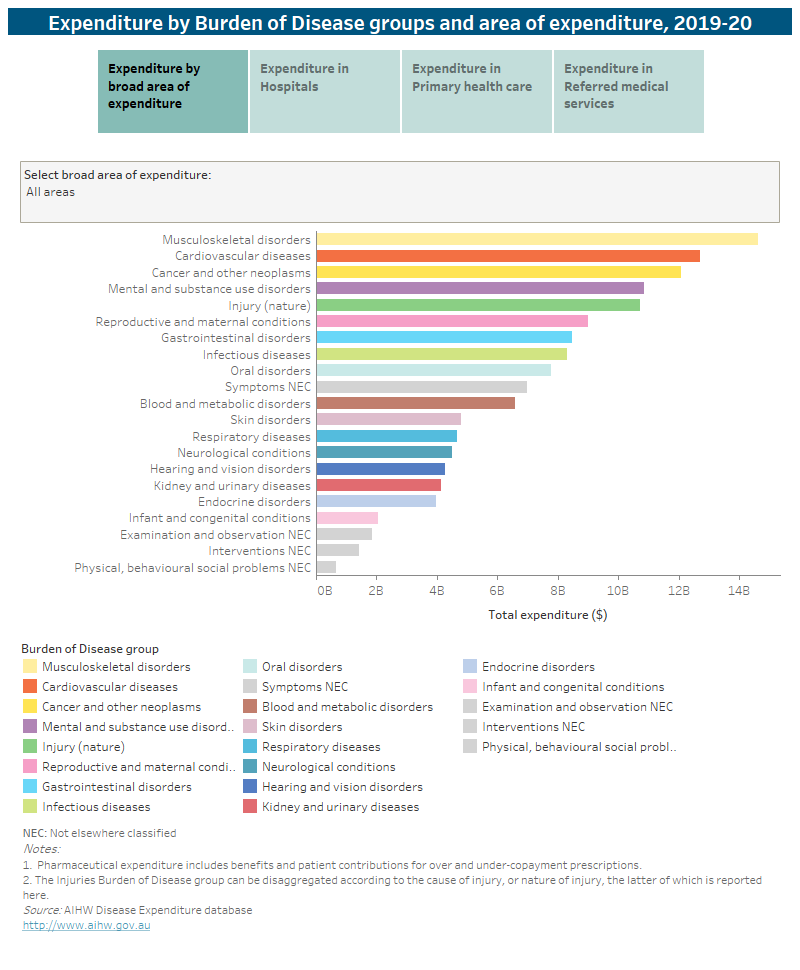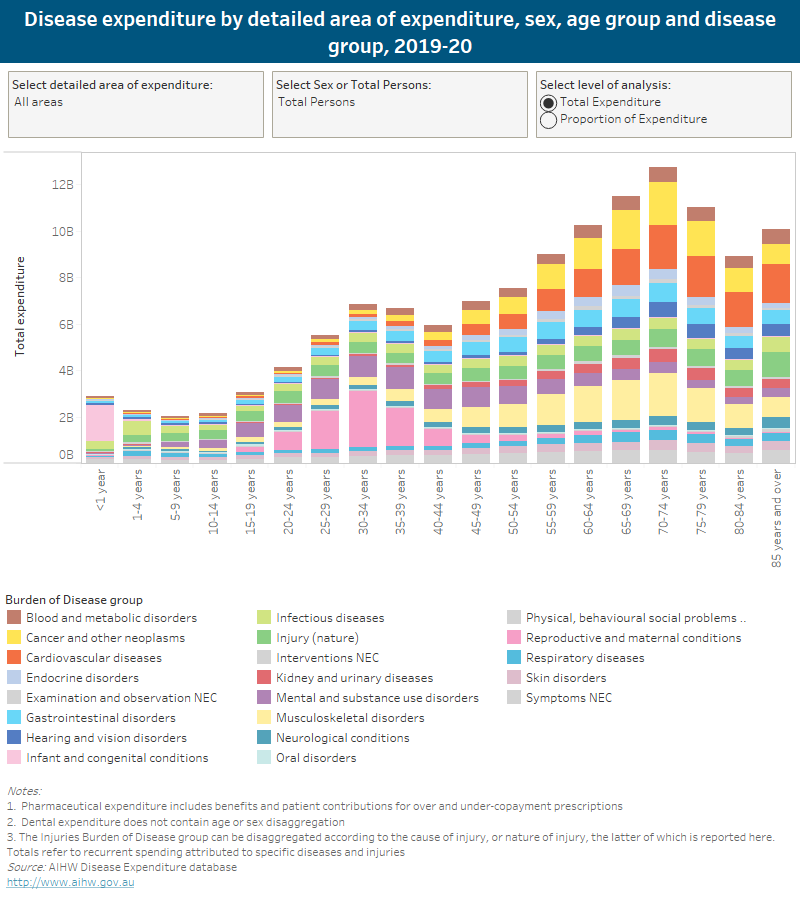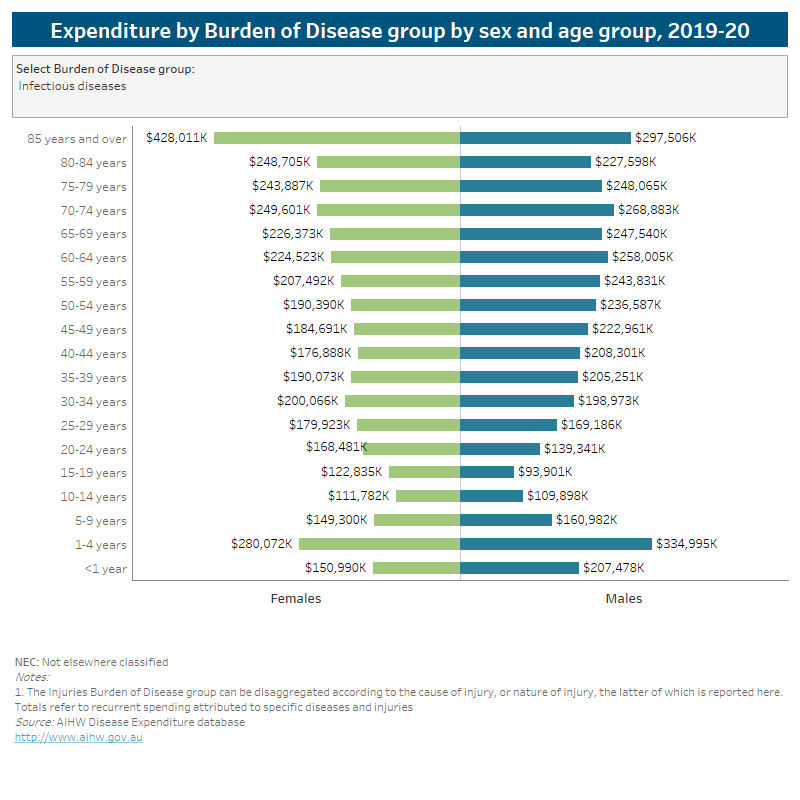Australian burden of disease groups
The Australian Burden of Disease Study (ABDS) condition list contains over 200 conditions in 17 groups. In this disease hierarchy, each disease is allocated to a disease group. The burden of disease groups contains related diseases or conditions–such as cardiovascular diseases, gastrointestinal disorders, or injuries–and one alternative reporting disease group (nature of injury instead of injury by external cause). These groups are listed in the figures below.
Not all health spending is directly related to a burden of disease condition or group. Some expenditure relates to interactions for purposes such as health maintenance (such as yearly health or dental checks) or investigation of potential health problems, which remain undiagnosed. These services are reported as signs and symptoms, interventions, examination and observation, and physical, behavioural social problems not elsewhere classified.
- The condition groups with the highest spending were musculoskeletal disorders followed by cardiovascular diseases, and cancer and other neoplasms.
- The disease groups with the highest spending for admitted patients in public hospitals were cardiovascular diseases, injury and gastrointestinal disorders. In private hospitals, these were musculoskeletal disorders, cardiovascular diseases and cancer and other neoplasms.
- Spending on general practitioner services was highest for infectious diseases, mental and substance use disorders, followed by musculoskeletal disorders and cardiovascular diseases.
- More than half of spending for allied health and other health practitioners related to mental and substance use disorders, with just under a quarter relating to hearing and vision disorders.
- There was a 10% increase in estimated spending for the infectious diseases group since 2018–19. This may partly be due to the spending on COVID–19, a new condition within the infectious diseases group. Refer to the COVID–19 section within this web report for further information.
The following interactive data visualisation can be used to display health spending for each disease group by area of expenditure. Data used to create the visualisations can also be downloaded as an Excel workbook.
This horizontal bar chart explores spending on different burden of disease groups by broad and detailed area of expenditure in 2019-20. Groups are listed in descending order of spending. Musculoskeletal disorders ranked first for hospitals and referred medical services, while oral disorders rankest first for primary health care. For specialist services cancer and other neoplams had the highest spending. Infectious diseases was the main reason people visited the GP in 2019-20.

The proportion of total spending related to condition groups varies substantially according to age group, sex, and area of expenditure.
- Within the infectious diseases group, spending was highest within the 1–4 and 85+ age groups.
- While spending on mental and substance use disorders peaked in the 35–39 age group with similar spending for males and females, spending was high for all age groups between 20 and 49.
- Spending on chronic conditions such as cancer and other neoplasms and cardiovascular diseases was highest for age groups from around age 55 onwards for males and females.
The following interactive data visualisation can be used to display spending on disease groups by age group and sex, for each area of expenditure. Data can be displayed as total expenditure or as a proportion of total expenditure. Data used to create the visualisations can also be downloaded as an Excel workbook.
This stacked vertical bar chart looks at the estimated spending in 2019-20 by sex and age group for each area of expenditure broken down by disease group. Overall, expenditure increases with age. Injury and Infectious diseases were the major contributors to Public hospital emergency admissions for all age groups. For females, over $1 billion was spent on admitted patients in public hospitals for Reproductive and maternal conditions. For males, the leading cause for being admitted in Public hospitals was due to Cardiovascular diseases.

This butterfly chart shows expenditure by Burden of Disease group by sex and age group for 2019-20. For both males and females, expenditure for disease groups increases with age. However, for the infectious diseases group the expenditure is the highest amongst the 1-4 year age group and the 85 years and over age group.



